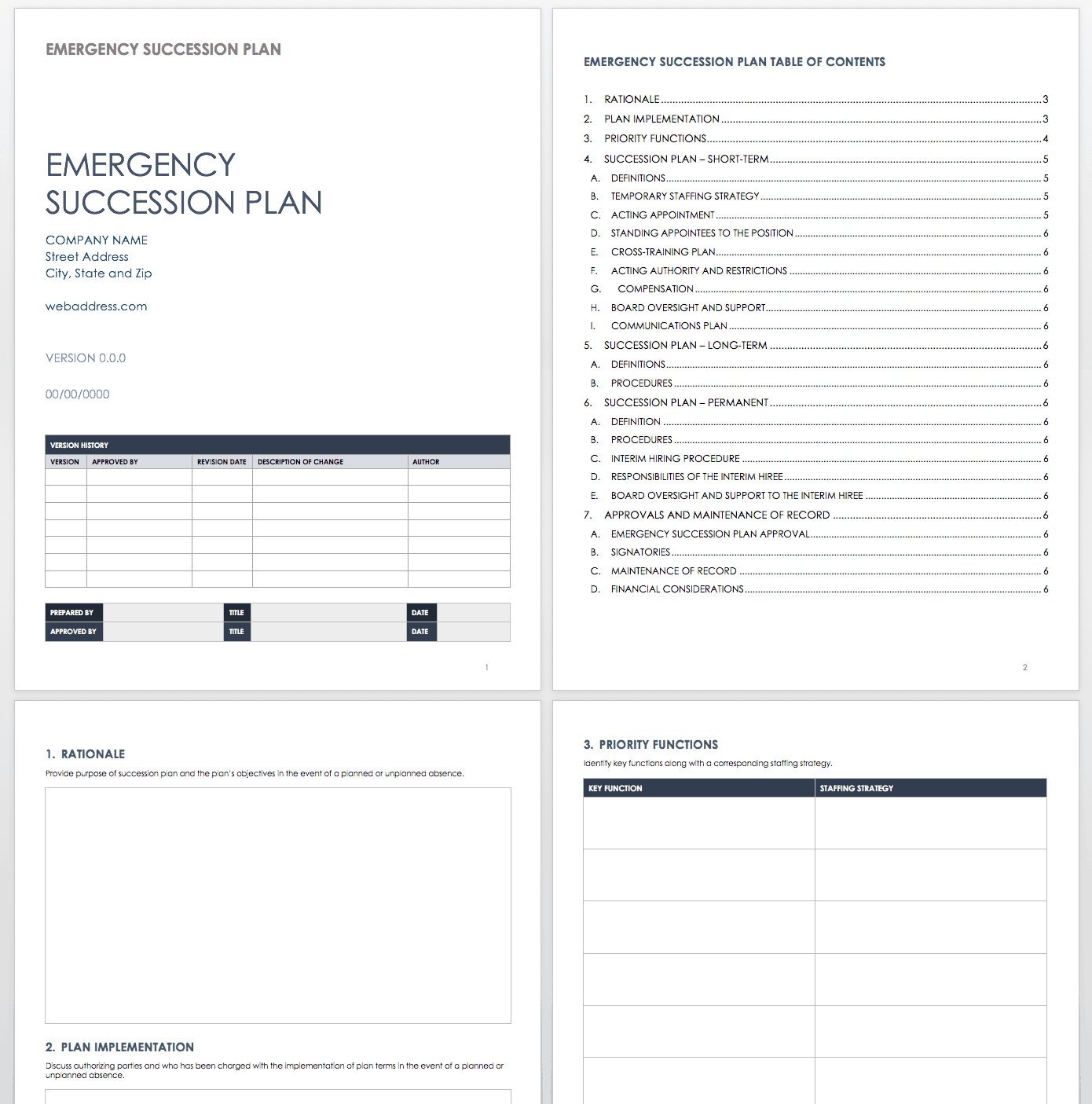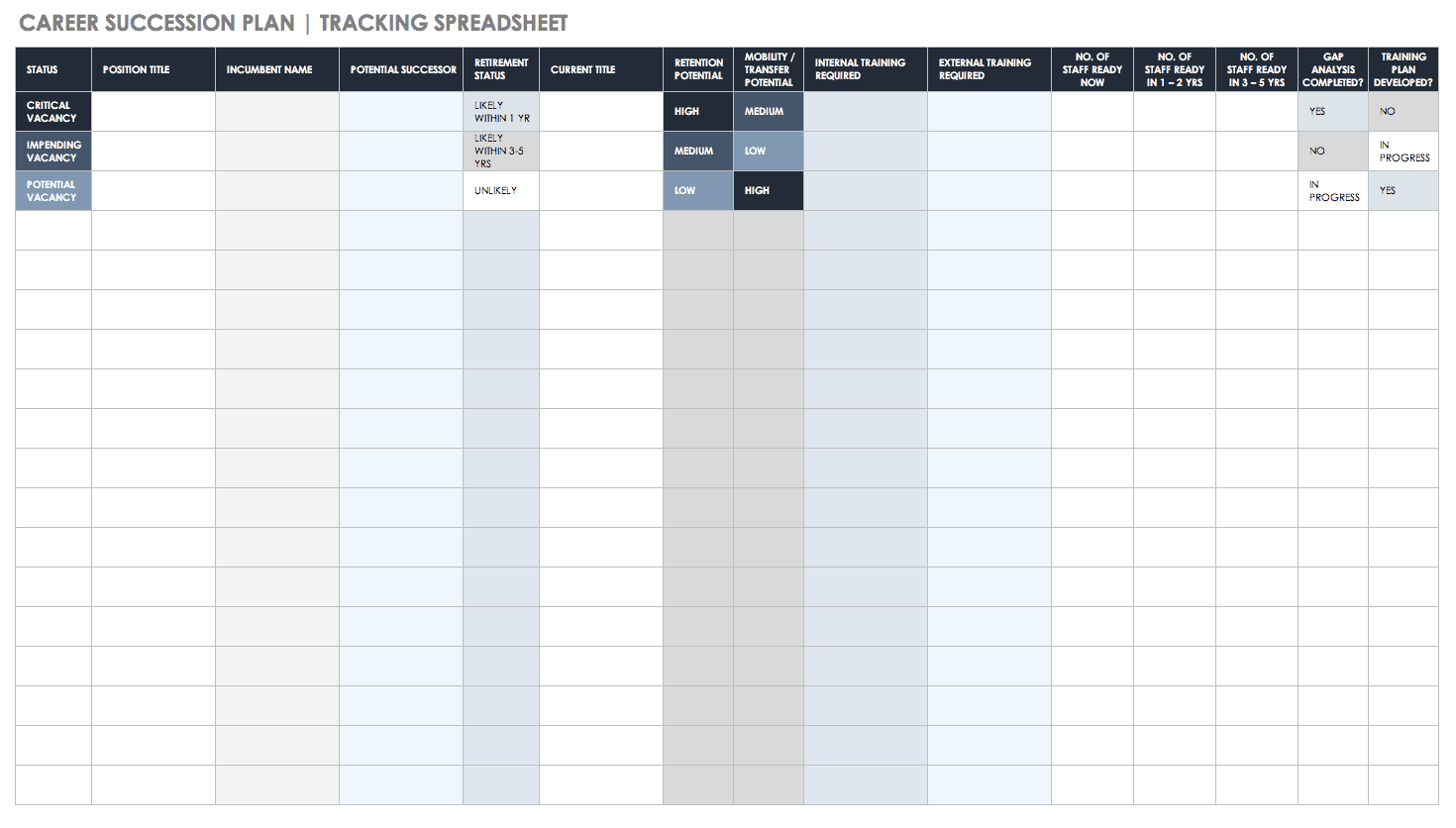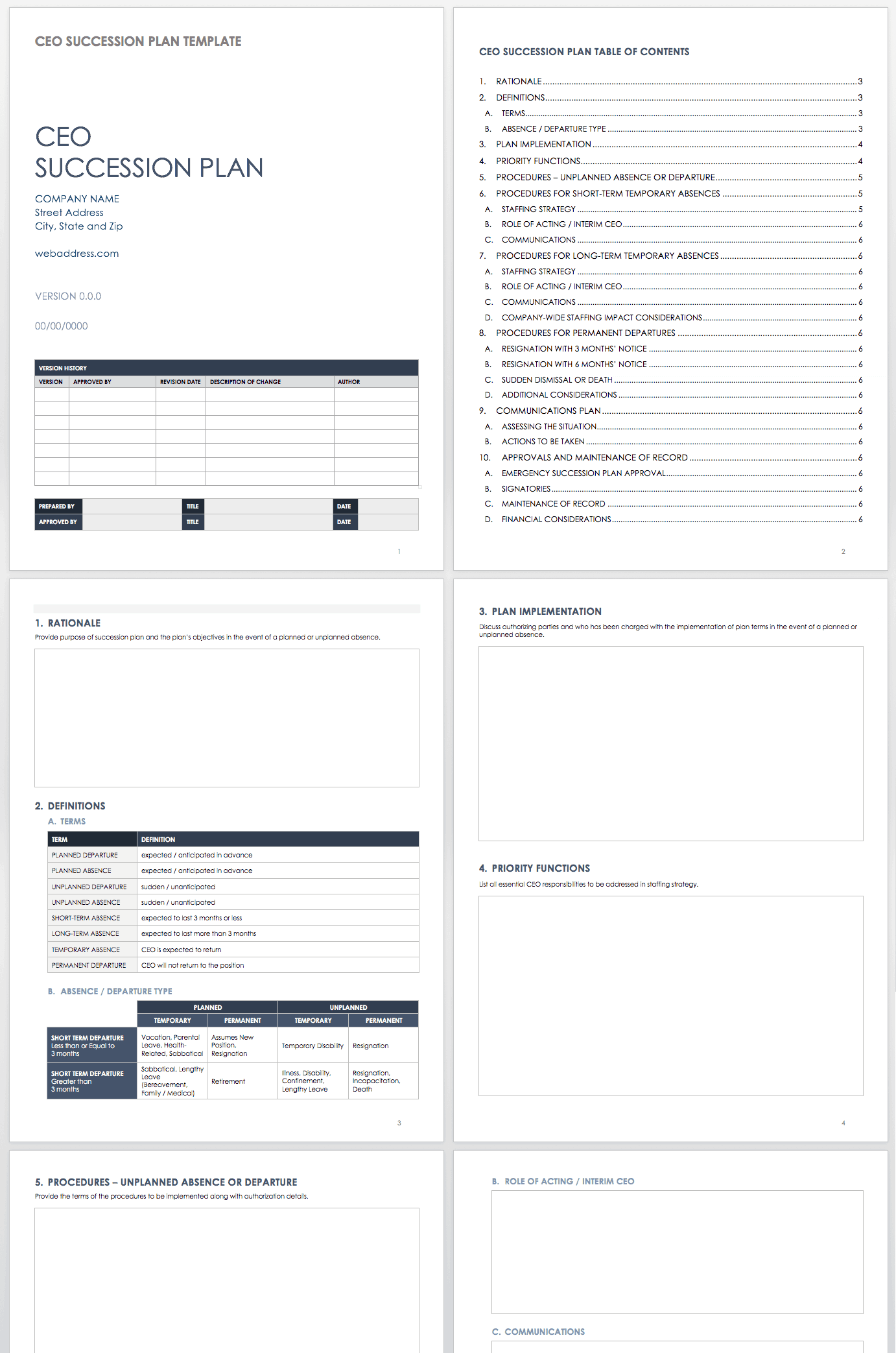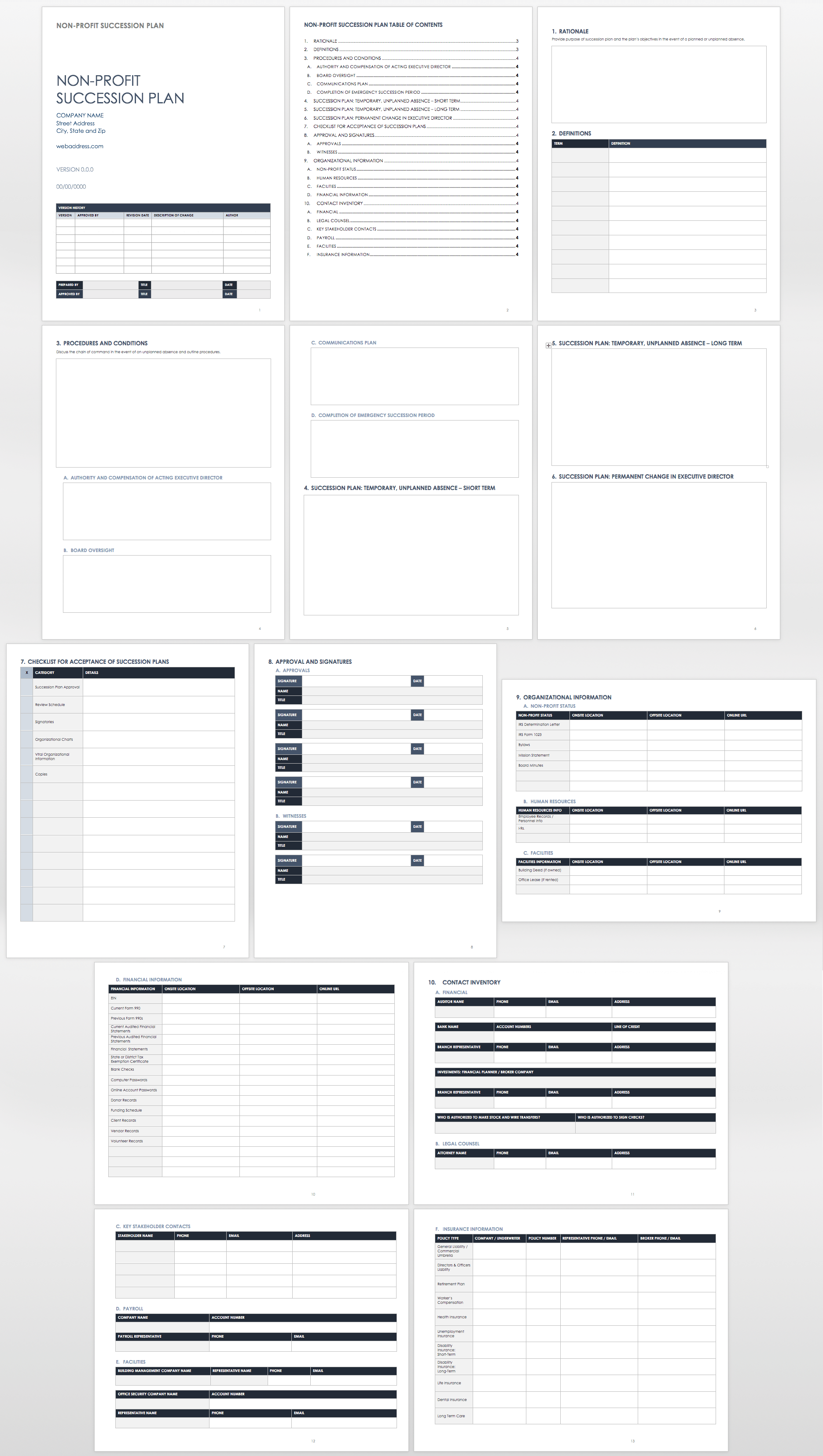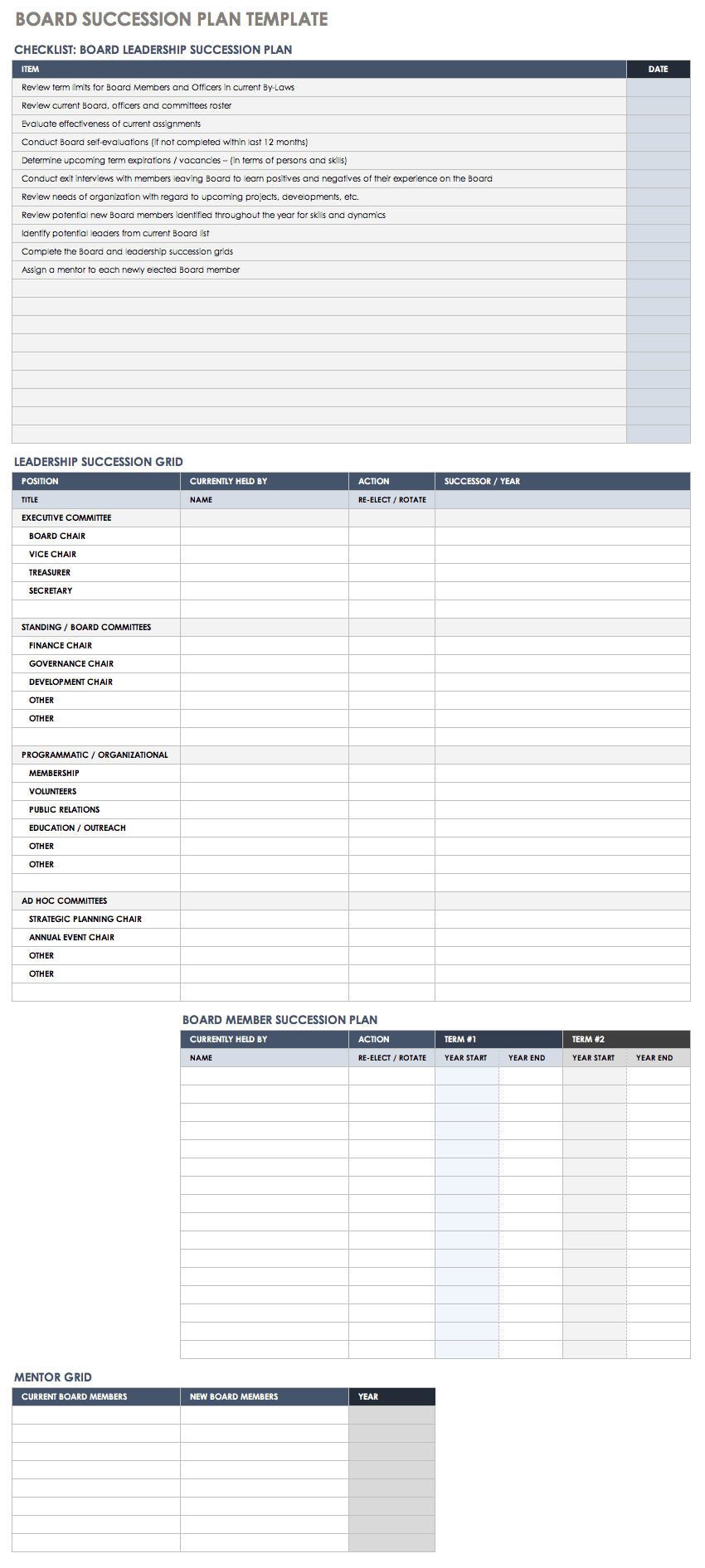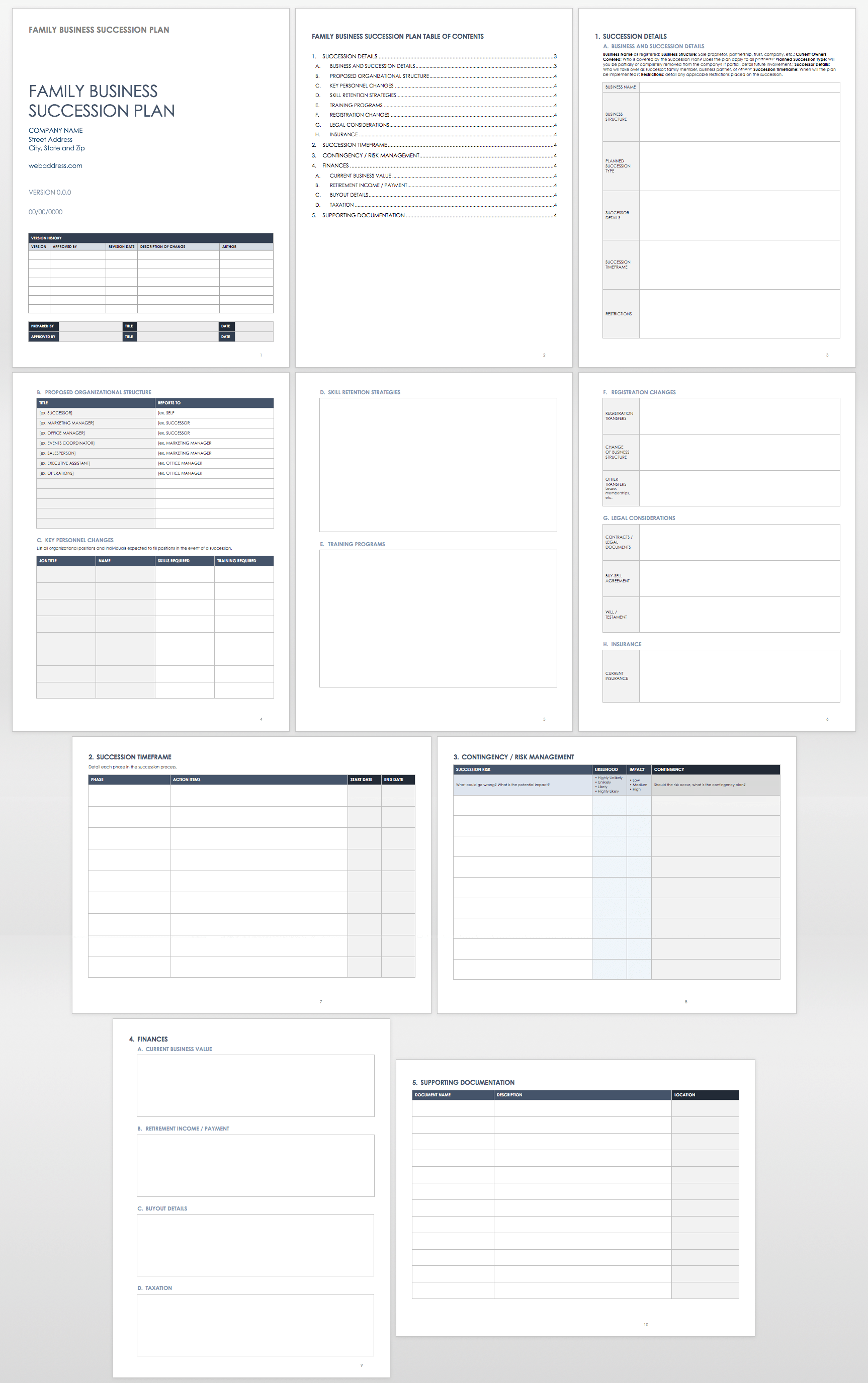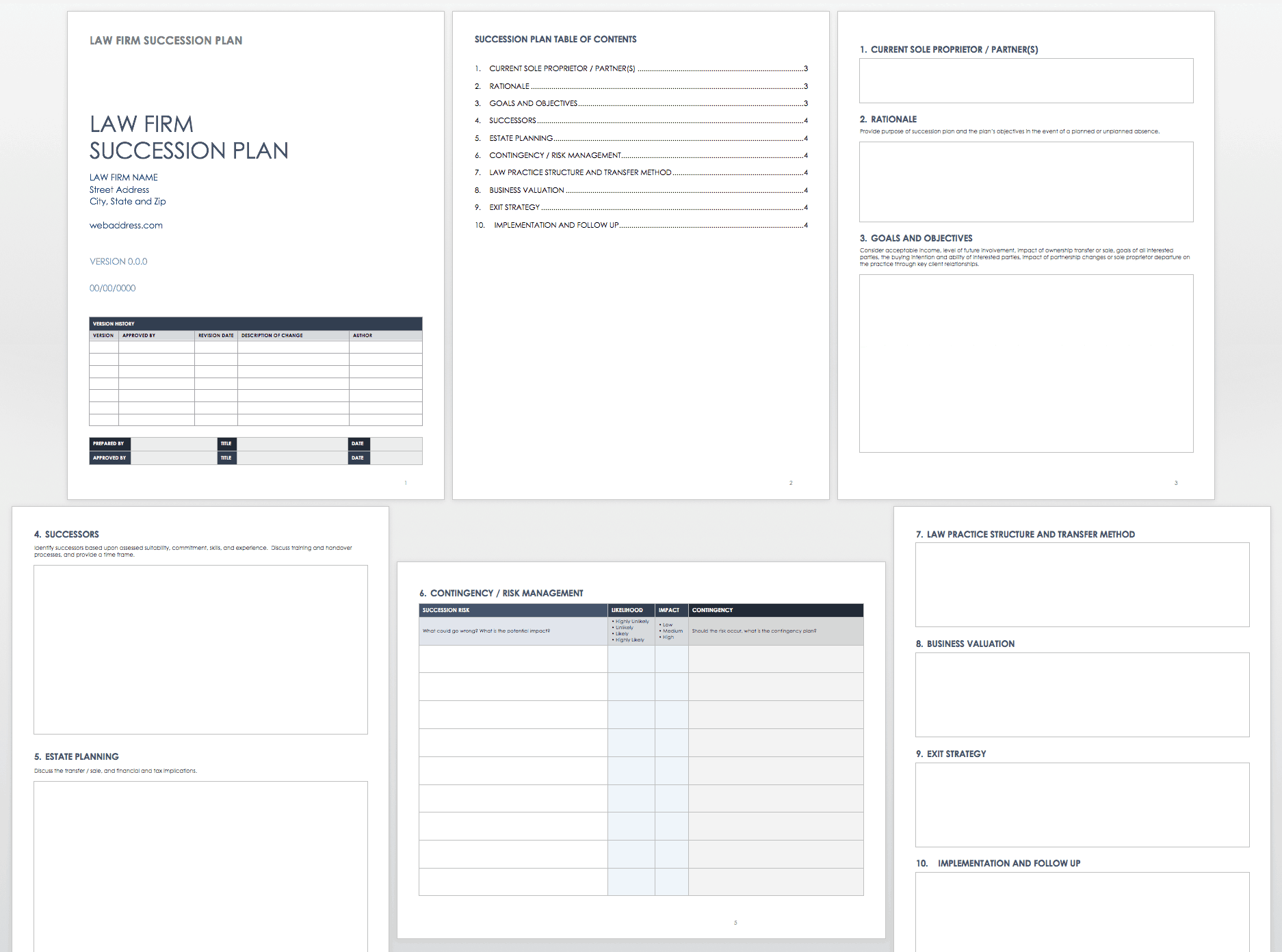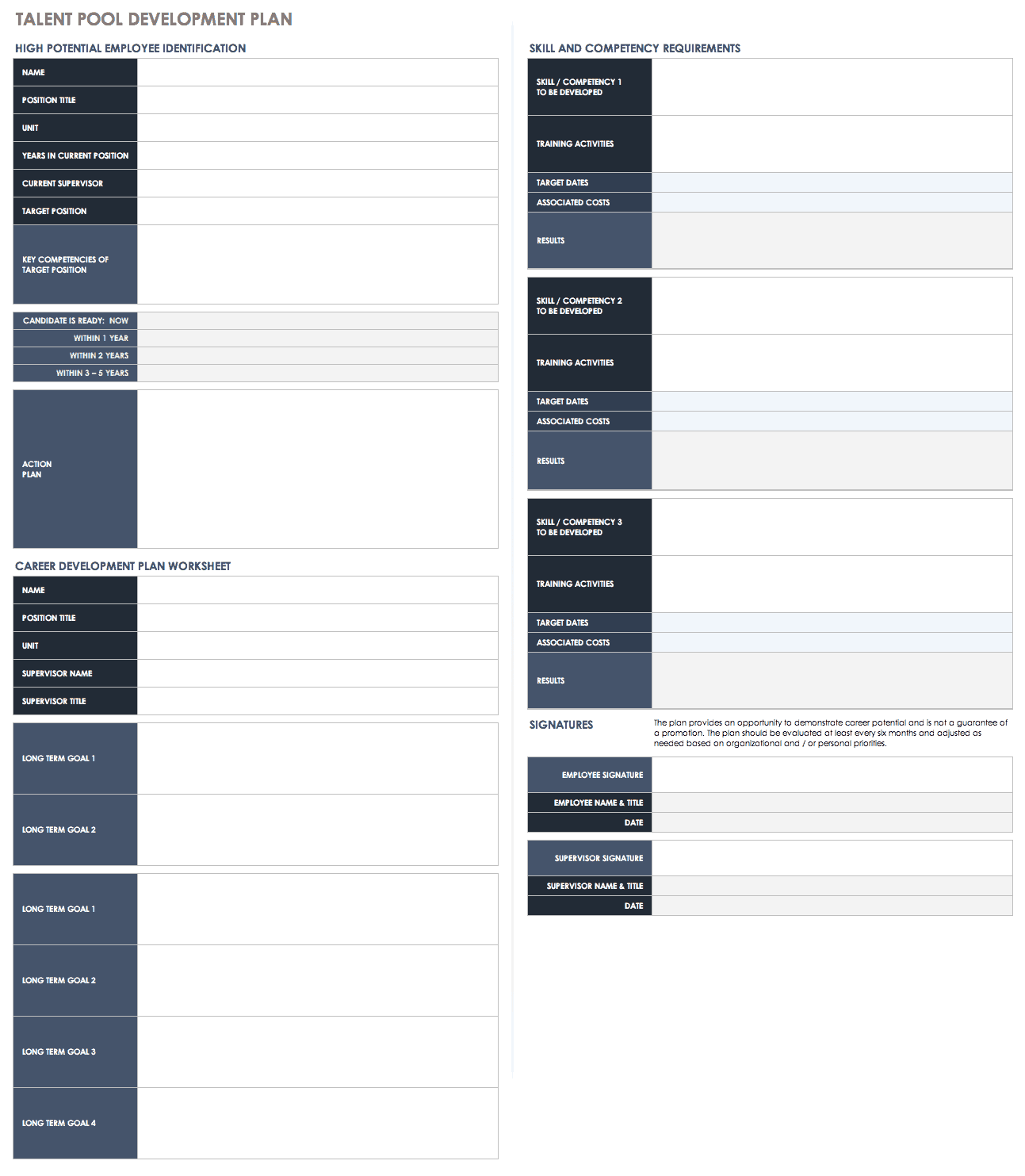Emergency Succession Plan Template
This template provides an outline for creating an emergency succession plan to help ensure a smooth transition when an unexpected leadership change occurs. Use the template to develop your own strategic plan for how to handle the temporary or unexpected absence of an executive director or similar role. Identify the key responsibilities of the role that need to be maintained, plans for interim or other hiring options, and procedures for implementing the emergency plan.
Download Emergency Succession Plan Template
Excel | Word | PDF | Smartsheet
Career Succession Plan Template
This comprehensive succession planning worksheet includes a spreadsheet for tracking multiple roles, retirement status, potential successors, required training, and other information. It also includes two sheets for detailed employee succession planning: One matches the competencies required for a position with those held by a potential successor, and the other focuses on internal and external training plans to help fill any competency gaps. This is an Excel template that you can easily modify to include additional data.
Download Career Succession Plan Template
CEO Succession Plan Template
Create an executive succession planning template to prepare for a planned or unplanned CEO departure. Use this outline to develop a thorough plan, whether for a temporary or permanent leadership change. The template includes sections for detailed procedures and communication planning. It also includes a section to closely examine the role of the CEO and the attendant responsibilities that need to be addressed.
Download CEO Succession Plan Template
Nonprofit Succession Plan Template
As with corporate succession planning, nonprofits need clear plans to help ensure continuity of leadership and management needs. Create a nonprofit succession plan to cover short-term, long-term, emergency, or multiple types of leadership change. Define procedures to be followed by staff and board members, clarify responsibilities for the board of directors, plan for communication with stakeholders, and provide a timeline for implementation. This template also allows you to compile key financial, legal, insurance, and other information for easy access.
Download Nonprofit Succession Plan Template
Board Succession Plan Template
Track the length of service for each board member and identify successors. This is a simple succession plan template that you can use to identify committee members and the roles they serve, list term years with start and end dates, and create plans for re-election or succession. Edit the spreadsheet to include any additional board member information that you want to keep track of.
Download Board Succession Plan Template
Family Business Succession Plan Template
Family businesses can use this template to create succession plans for retiring owners, for the sale of a business, or for unexpected leadership changes. Determine whether family members will be successors and what skills they need to develop in order to be prepared. Define the organizational structure, personnel changes that will take place in the event of a succession, legal and financial considerations, and risk management plans for potential issues.
Download Family Business Succession Plan Template
Law Practice Succession Planning Template
Whether you’re a sole proprietor or partner in a law firm, this succession planning template provides a basic outline for creating concrete goals related to retiring or transferring ownership, identifying capable successors, making a timeline for implementing the succession plan, and more. Create a sense of security for your law practice by setting a clear plan and reviewing it regularly.
Download Law Practice Succession Planning Template - Word
Talent Pool Development Template
This worksheet is designed to help you identify high-potential employees in order to create a talent pool for future positions. These are employees who, with the right career development, could be successors to important leadership positions. Use the worksheet to find key competencies and create an action plan for employees to gain skills and reach goals. Keep track of training and other activities, along with associated results.
Download Talent Pool Development Template
How to Create a Succession Planning Template
Once you have selected a template that works well with your business or organizational needs, you can customize it to create a personalized succession plan. Here are some of the elements commonly included in a succession plan:
- Position: This may be one or multiple positions, usually leadership positions, that you will need to fill in the case of a planned or unexpected absence. The plan can provide a detailed look at the key functions of and competencies required for this position.
- Incumbent: This refers to the person currently in the key role.
- Candidates: This is a list of potential employees or others (such as candidates for board membership) who have the skills to move into key roles.
- Readiness Rating: Evaluate candidates to determine current competency levels and gaps that need to be filled. A rating is a quick way to indicate how ready a candidate is to move into the role, and may be based on a range of factors, including performance ratings, specific skills, willingness and ability to relocate, and other assessments.
- Development Needs and Action Plan: Whatever competencies a candidate lacks will need to be developed. A specific plan shows training or other actions that the organization will take to manage this development and track its progress.
- Organizational Chart: Some succession plans include a visual description of key roles and may include photos of the incumbent and candidates in addition to names and other details.
Other common details include communication planning, retention risk information for the incumbent or candidates, procedural guidelines for an emergency absence or a temporary leave, financial and legal information, and more. In some cases, a simple spreadsheet is adequate for identifying talented candidates, planning action steps, and tracking progress. A more comprehensive plan includes supporting documents and clear guidelines for ensuring that leadership roles and management functions continue without interruption.
The Benefits of Succession Planning
Succession planning can support businesses and employees by increasing staff retention, improving performance, and boosting employee confidence. It assists in identifying the critical positions within an organization and tracking potential vacancies so that you can prepare for future personnel needs. It is also a way of aligning future business objectives with employee development by helping high-potential employees gain the knowledge, experience, and skills they need to take on leadership roles. Employees get the benefit of advancing toward promotion, and businesses can help ensure that they fill current and future positions with the right candidates.
Businesses can save money by investing in internal employees, improving staff retention, and preparing for unexpected leadership losses. Succession planning also helps create smoother transitions, whether they’re related to organizational expansion, the sale of a business, retirement, or an emergency situation. Moreover, it can help fill new positions by providing a talent pool that you can draw from. You need to review and update a succession plan regularly so that planning and employee management become ongoing processes.
The Succession Planning Process
Succession planning has at least three stages: identifying future business challenges and key roles, evaluating and selecting employees based on critical competencies, and preparing those employees to fill future positions. Here’s a closer look at some of the steps involved:
- Strategy: Connecting succession planning to strategic business planning just makes sense. Defining challenges and goals for the future provides information about what roles you will need moving forward. Identifying the negative effects (on an organization) of the absence of key positions helps to clarify what competencies, skills, and knowledge are critical for business continuity. Strategizing is also an opportunity to engage senior leaders in the process and help staff understand their roles. Tracking when key positions are likely to become vacant can also help create a more specific timeline for succession.
- Candidates: Create a list of possible candidates based on potential for leadership roles. Of course, the selection process needs to be fair, that is, based on a standardized evaluation process and criteria related to critical competencies and the future potential of each employee. Once you’ve created a talent pool, you can make training plans to fit the competencies that each candidate needs to develop. In order for an employee to accommodate development opportunities, you may need to adjust their schedule or workload. It’s possible that, without undergoing further training, education, or certification, a candidate may already be qualified to fill a position that is not yet open. In that case, be sure to keep them engaged — otherwise, you risk losing a potential leader to another organization.
- Progress: Reviewing and updating plans on a regular basis allows you to track progress and meet milestones. Create a timeline that fits with strategic plans and upcoming vacancies, and include contingencies in case an unexpected transition occurs.
Succession planning may sound like an overwhelming endeavor, but given the potential benefits, it’s worth the investment now to avoid undue challenges later. And, according to the Society for Human Resource Management (SHRM), succession planning might be easier than you think once you break down the process into steps.
Improve Succession Planning with Real-Time Work Management in Smartsheet
Empower your people to go above and beyond with a flexible platform designed to match the needs of your team — and adapt as those needs change.
The Smartsheet platform makes it easy to plan, capture, manage, and report on work from anywhere, helping your team be more effective and get more done. Report on key metrics and get real-time visibility into work as it happens with roll-up reports, dashboards, and automated workflows built to keep your team connected and informed.
When teams have clarity into the work getting done, there’s no telling how much more they can accomplish in the same amount of time. Try Smartsheet for free, today.
